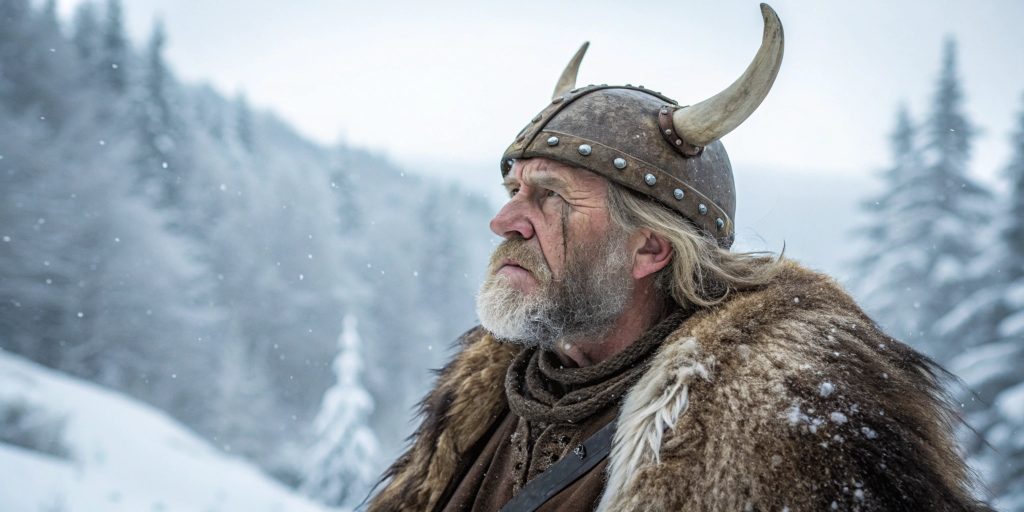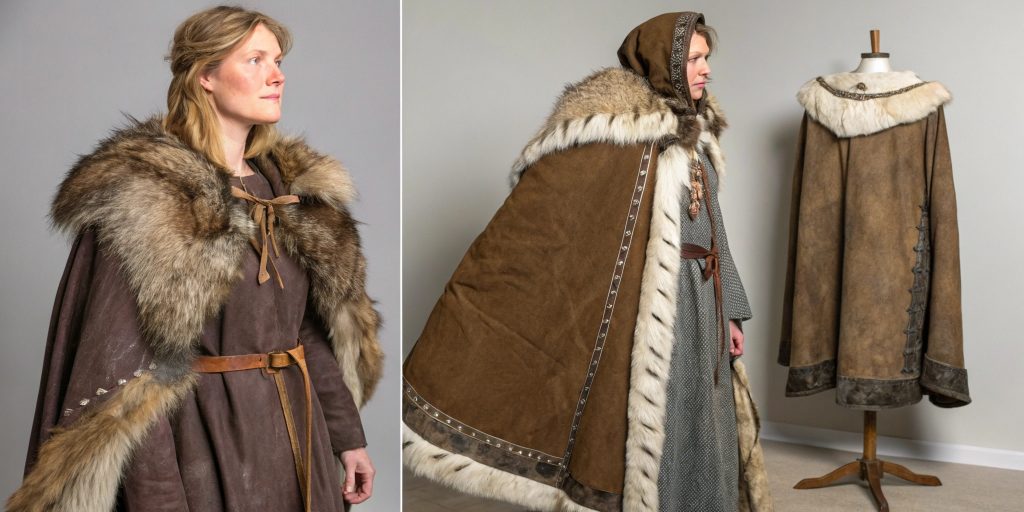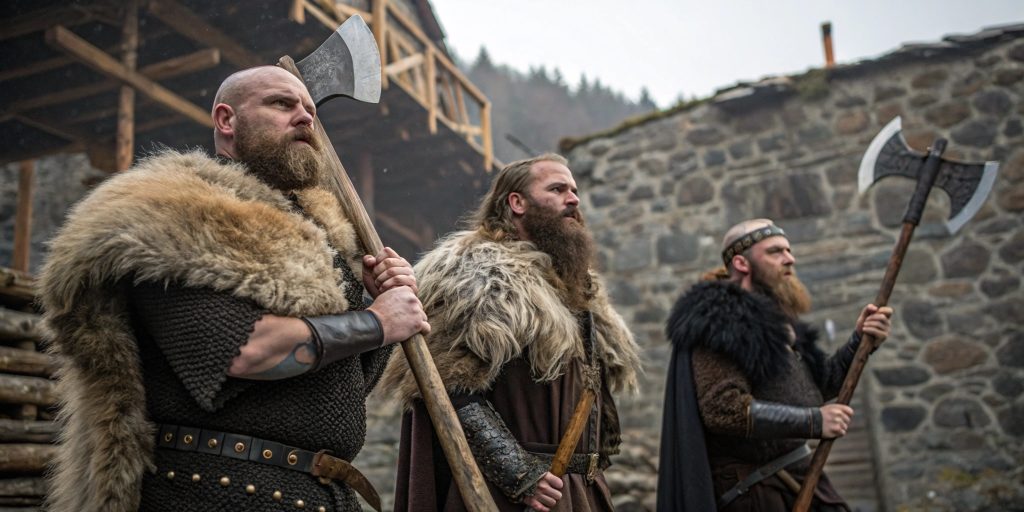Daily Life in the Viking Age, Viking Clothing and Jewelry, Vikings
Why Did Vikings Wear Animal Skins?
The Vikings were known for their bravery and skill in the sea. They wore animal skins for warmth and protection, which was crucial in the cold lands of Scandinavia. These skins served as female traditional Viking clothing.
Animal skins were more than just clothes. As seen in stories from the Viking Age, they showed a Viking’s status and identity.
The Role of Animal Skins in Viking Clothing
Animal skins played a big role in Viking clothing. They were not just for keeping warm. They showed the Vikings’ deep connection to nature. Skins from deer and bears made clothes soft, warm, and firm.
This connection to nature helped the Vikings make clothes that showed their resourcefulness. They could adapt well to their surroundings.
The seasons changed how Vikings dressed. In cold winters, they wore thick animal skins. In warmer times, they chose lighter ones, often made of fabrics that could be easily fastened. This shows how smart they were in dealing with the weather.
The Vikings were also skilled at decorating their clothes with animal skins. They made beautiful designs that show their artistic side.
Using animal skins in their clothes was more than practical. It was a way to express themselves, showing their creativity and love for nature.
Practical Uses of Animal Skins for Warmth
Animal skins were key to keeping warm in Viking clothes. They were vital for survival in Scandinavia’s cold. Heavy furs were a must.
Vikings layered their clothes for better warmth. They used a three-layer system:
- A base layer, often made from linen or wool.
- An animal skin as the middle layer added significant warmth.
- A protective cloak on the exterior to shield against the wind and rain.
This layered approach kept them comfortable and mobile, allowing them to fasten their clothing effectively. Winter garments, like fur-lined hoods and gloves, showed Viking skill. They made functional and stylish clothes, often choosing to embroider their garments.
What Did Vikings Wear: Materials and Options
Vikings were very skilled at making clothes from different materials. They chose materials wisely, which helped them make many types of clothes. They used animal skins for warmth and durability, and wool and linen made their clothes more comfortable and stylish.

Types of Animal Skins Used
They used skins from:
- Sheep
- Oxen
- Reindeers
- Goats
These skins were perfect for the cold Nordic weather. They were often dyed in natural colors. This gave Vikings many choices for their clothes, including the option to comb different styles together.
Wool and Linen: Complementary Fabrics
Wool kept Vikings warm in cold weather, while linen, made from flax, was cool in warm weather. Wool, linen, and animal skins helped Vikings make clothes for all seasons.
Cultural Significance of Animal Skins in Norse Society
Animal skins meant more than clothes in Viking society. They showed a deep bond with nature and the Vikings’ respect for it. Wealthy people wore fancy clothes with expensive furs, while poor folks had simpler outfits.
Different animal skins had special meanings. Bear skins were loved for their strength and bravery. But other skins told stories of local traditions and places, often embroidered with unique designs.
The way Vikings dressed with animal skins showed their social status. It also showed their values and beliefs, often represented through the tapestries they wore. Choosing certain skins showed their skill, identity, and place in society.
How Animal Skins Reflect Status and Identity
Animal skins in viking attire showed status and identity. Vikings knew their clothes showed their place in society. Different skins meant different things, like social rank or achievements.
Symbolism in Viking Attire
Symbolism was key in Viking clothes. Animal pelts showed cultural identity. Warriors might wear special skins to show their bravery and straps to fasten their armor securely.
Colors and designs told even more, as Vikings wore garments embellished with amber beads. Specific colors or patterns showed clan loyalty or high status, and Vikings also wore beads to signify their importance.
- Cloaks with fancy patterns showed wealth and skill.
- Furs from rare animals in Viking-era clothing showed exclusivity and high status.
- Silver or gold thread told stories of power and importance, often used to fasten cloaks.
Vikings used clothes to shape their identities. They showed who they were and how they wanted to be seen. Animal skins, symbols, and identity were all part of the Viking way of life.
Viking Women and Their Use of Animal Skins
In the Viking era, Viking women played a big role in making textiles. They didn’t just make clothes for warmth; they also showed off their style and identity. Their work mixed beauty with usefulness, using animal skins and other materials.
Women’s Clothing in the Viking Era

Female traditional Viking clothing included long wool dresses layered for warmth and style. They also wore fur-lined shawls and small animal skins to stay warm and stylish. This allowed them to show their unique style with different textures and colors.
Accessories were key to their outfits. Viking women used brooches and belts to keep their clothes in place. These items were functional and a way to express their fashion sense. Using animal skins showed their connection to nature and their fashion sense.
Archaeological Evidence of Viking Clothing
Archaeological finds give us a peek into Viking clothing. Excavations have uncovered pieces of viking clothing. These show the Vikings’ skill in making clothes.
These findings also tell us about the materials used. They show that clothes were more than just clothes; they were a part of Viking culture.
Notable Finds from Viking Graves
The Oseberg ship burial is famous for its clothes. They were made from wool and animal skins. These clothes had embroidery and metal fastenings.
These show the Vikings’ love for beauty and identity. They also found leather shoes and accessories, which show the Vikings’ care for detail and use of animal skins.
- Preserved garments from notable sites
- Detailed craftsmanship evident in fastenings and designs
- Variety of accessories found alongside clothing
Viking Fashion Trends and Styles
Viking fashion was a mix of function and beauty, often incorporating undyed materials. It showed their deep bond with nature. They wore tunics, trousers, and cloaks, usually sewn with belts around the waist for a good fit and sometimes adorned with glass beads.
As you looked at Viking clothes, you saw how wealth mattered. Wealthy people wore fancy clothes made from expensive fabrics with decorations.
Viking women wore long dresses with fancy brooches that showed their status. Men, on the other hand, wore simple wool tunics. These clothes were simple yet had a unique charm.
As Vikings met other cultures, their fashion changed. They added new styles and influences to their clothes. This mix of styles in Viking-era clothing showed their tastes and the changing trends of the Viking era.
Techniques for Preparing Animal Skins
Preparing animal skins was key for Vikings. They mixed art with function, making materials for their community. Tanning uses natural materials to create strong, long-lasting skins.
Vikings used many techniques with what they had. They used:
- Tree bark for its tannins to preserve skins, a technique that Vikings also employed for their historical Viking garments.
- Animal brains for oils to soften leather, which Vikings also used to create durable straps.
- Animal fats for better texture and strength.
How they prepared skins changed based on their needs. Furs stayed hairy for warmth in the cold, and hides became leather for shoes and belts.
This skill shows Viking’s smartness and resourcefulness. It gave them useful clothes and showed their bond with nature.
Conclusion
Viking clothing shows how much the Vikings loved and respected their environment. Animal skins were key to their clothes and told a lot about their culture and who was important. They used everything from thick Arctic fur to beautifully dyed leather.
Looking at Viking clothes tells us more than just how they dressed. It shows who they were and their place in society. Clothes for men and women showed their status and role in the community. This was very important in Viking culture, as men wore clothing that reflected their status.
Today, archaeology finds new things, including tapestries, that help us better understand the Vikings. Their clothes were not just old things; they showed creativity, skill, and connection to their world. Viking clothes are still fascinating to study. They mix usefulness, beauty, and cultural meaning especially.

